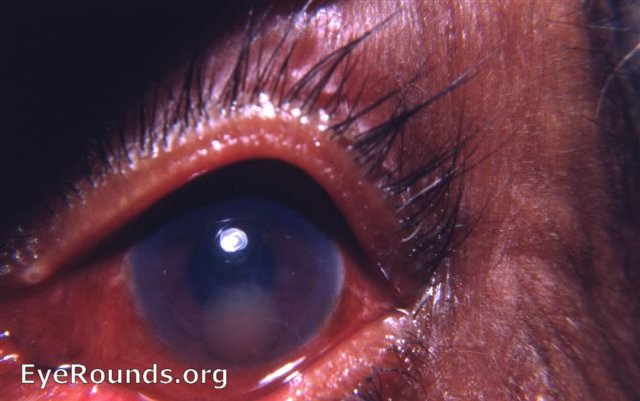EyeRounds Online Atlas of Ophthalmology
Contributor: William Charles Caccamise, Sr, MD, Retired Clinical Professor of Ophthalmology, University of Rochester School of Medicine and Dentistry
*Dr. Caccamise has very generously shared his images of patients taken while operating during the "eye season" in rural India as well as those from his private practice during the 1960's and 1970's. Many of his images are significant for their historical perspective and for techniques and conditions seen in settings in undeveloped areas.
Category: Cataract
Morgagnian cataract (shrunken with the nucleus enclosed in the lens capsule now lying in the anterior chamber)

From 1951 through 1968, the hypermature Morgagnian cataract was one of the cataract forms most frequently encountered in the OPD of the Eye Clinic and therefore encountered in the OR. The shrunken Morgagnian cataract is rarely discussed in any detail in the literature. Dr. Caccamise's experience with this rare form of cataract was as follows: In some cases, the status of the cataract had not been recognized pre-operatively. The pupil had resisted dilation and slit-lamp examination suggested a nuclear cataract - perhaps even a cataracta nigra. In the operating room it was soon recognized that a shrunken Morgagnian cataract, i.e. a Morgagnian cataract that had lost all of its liquefied cortex with only the totally encapsulated sclerosed nucleus remaining, was at hand. Once the situation had been accurately determined, the cataract was easily removed by the Snellen loop technique. If the extracted cataract was held between the index finger and thumb and then rubbed, it became apparent that the nucleus was contained within an intact lens capsule. All of the liquefied cortex that had been contained within the Morgagnian cataract's capsule had slowly leaked out withot causing phacolytic glaucoma prior to surgery. In the photograph, the lens nucleus enclosed within the intact lens capsule had luxated into the anterior chamber. The displaced nucleus - and perhaps some of the leaked cortex -had caused a phacolytic glaucoma. The eye was easily rescued by surgery employing the Snellen loop maneuver to extract the nucleus with its intact lens capsule.


Ophthalmic Atlas Images by EyeRounds.org, The University of Iowa are licensed under a Creative Commons Attribution-NonCommercial-NoDerivs 3.0 Unported License.


